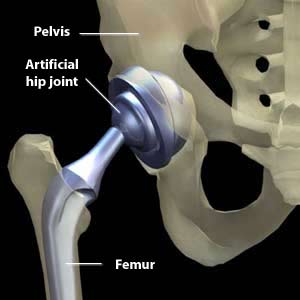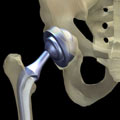Description of the procedure
During hip replacement surgery, the damaged hip joint is removed and replaced with an artificial joint (called a prosthesis). Metal, plastic, and ceramic are common choices of material for the new joint. Having a new hip allows many people to live with less pain and greater freedom to move.
Needing a hip replacement is often age-related. People 60 and over are more likely to have the procedure than younger individuals.
This procedure is usually performed by an orthopedic surgeon. The surgery is done under anesthesia in a hospital setting.
When should this procedure be performed?
Doctors perform this procedure as required. The new hip joint does not need adjustment unless a problem arises with it. It is difficult to predict exactly how long a hip replacement will last because each person's circumstances vary. After 15 or 20 years, the joint may wear out through normal use. People who undergo hip replacement surgery before the age of 60 may need to have additional surgery.
Why is this procedure performed?
Usually, treatment for hip problems begins with pain medication, walking aids, and physical therapy to control discomfort. If this fails, doctors may suggest a hip replacement. Because hip problems cause pain, decrease a person's mobility and range of motion, and affect social or daily activities, hip replacement presents an appealing option for people in reasonably good health.
Conditions that may contribute to the need for a hip replacement include bone cancer, osteoarthritis, rheumatoid arthritis, a broken hip, and bone deformity.
Are there any risks and precautions?
Certain risks are common to all surgery and anesthesia. These risks depend on many factors including the type of surgery and your own medical condition. The possible, but very rare, side effects include: side effects of the anesthetic, breathing problems, infection, bleeding, scarring, and death.
Although hip replacement is generally considered safe, it does have some risks of side effects or complications. Infection of the incision or at the site of the replacement may occur. Contact your doctor immediately if you experience fever, pain, or swelling. Antibiotics will normally clear up a bacterial infection, but other treatments may be necessary. You may also experience a reaction to the anesthetic used in the surgery.
Blood clots may also form. These clots may form in the leg, causing inflammation of the blood vessels. They may also travel to the heart, brain, or lung and cause a heart attack, stroke, or pulmonary embolism. Speak to your doctor about your personal risk of blood clots and how to prevent these complications. Most people who have hip replacement surgery receive medications to prevent blood clots.
There is also a risk of experiencing problems with the joint. The artificial hip may dislocate or break, or become loose or stiff. Artificial joints used in hip replacement procedures may wear out over time. Speak with your doctor to find out how you can prolong the life of your new joint. If the artificial joint no longer works, you may need another procedure to determine why it is no longer functioning properly.
After the surgery, you may find that one of your legs is slightly longer or shorter than the other.
If you are concerned about any symptoms following this procedure, speak to your doctor. Take the time to be sure you understand all the risks of complications and side effects as well as any precautions you or your doctor can take to avoid them. Be sure your doctor understands all your concerns.
What happens during the procedure?
- You are given anesthesia.
- Then the surgeon makes an incision to expose the joint.
- The "ball" on top of your thigh bone is removed along with any damaged bone or cartilage in the hip socket.
- The new artificial joint is inserted.
- The incision is then closed and you are moved to the recovery room.
The procedure usually takes 1 to 2 hours.
How should I prepare for this procedure?
Before having this procedure, discuss the advantages, disadvantages, long-term risks, and consequences associated with the procedure with your doctor. Be sure you fully understand what will happen and are comfortable with your doctor’s answers to your questions.
Your complete medical history will be documented and an examination of the hip will take place before the procedure. The doctor performing the procedure may also request other tests to understand your joint's performance. Bone density tests or magnetic resonance imaging (MRI) may help assess the joint.
Do not eat for 8 hours before the procedure. You may be able to continue to drink clear liquids until 2 hours before the procedure. If your doctor has recommended different times, follow the timing recommended by your doctor.
Tell your doctor or prescriber about all prescription, over-the-counter (non-prescription), and herbal medications that you are taking. Also tell them about any medication allergies and medical conditions that you may have.
Ask your doctor or pharmacist whether you need to stop taking any of your medications before the procedure.
To make your living space comfortable after you return home, think about making changes to it before your surgery. If you have stairs in your home, consider avoiding them by moving items you need on a regular basis to a lower floor. It may be wise to plan most of your daily activities for a floor with a washroom.
Arrange for someone to drive you home from the hospital and have someone help with your daily activities for the first few weeks.
What can I expect after the procedure?
After surgery, you will be awakened in the recovery room. At this time, you will likely feel groggy, sore, and possibly nauseated. Nurses will be available if you need help. It is normal to spend 3 to 5 days in the hospital after the procedure, and to be on a few medications for the prevention of clots and infections. You need this time to recover, and doctors use this time to monitor your progress before sending you home. Before you go home, the doctor or nurse will go over what you need to do at home to complete your recovery.
Most people experience pain and swelling. Pain medication can help control the discomfort. As you begin to recover, you will be encouraged to move around to keep the new joint from becoming stiff and to prevent blood clots from forming.
Moving around will be difficult after the procedure until the new joint heals. You may need crutches to get around. Slowly, you will begin to resume walking. At the same time, you will need to do physiotherapy and exercises to strengthen the hip. Your doctor or physiotherapist will advise you about which activities are safe for you and which you should avoid.
The length of the recovery period varies from person to person. In general, it takes about 6 to 8 weeks before you can return to most normal daily activities. Some people will need longer to recover than others. Ask your doctor when it will be safe for you to resume your usual activities.
Results
Hip replacement surgery can help relieve pain, improve mobility, and increase the quality of life for people with certain hip problems.
All material copyright MediResource Inc. 1996 – 2024. Terms and conditions of use. The contents herein are for informational purposes only. Always seek the advice of your physician or other qualified health provider with any questions you may have regarding a medical condition. Source: www.medbroadcast.com/procedure/getprocedure/Hip-Replacement



